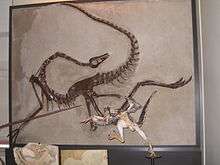Dromiceiomimus
| Dromiceiomimus Temporal range: Late Cretaceous, 73.5–68.5 Ma | |
|---|---|
| | |
| Skull cast | |
| Scientific classification | |
| Kingdom: | Animalia |
| Phylum: | Chordata |
| Class: | Reptilia |
| Clade: | Dinosauria |
| Order: | Saurischia |
| Suborder: | Theropoda |
| Clade: | †Ornithomimosauria |
| Family: | †Ornithomimidae |
| Genus: | †Dromiceiomimus Russell, 1972 |
| Species | |
| |
Dromiceiomimus is a genus of ornithomimid theropod from the Late Cretaceous (early Maastrichtian) of Alberta, Canada.
Taxonomy

The type species, D. brevitertius was originally described as a species of Struthiomimus by William Parks in 1926 on the basis of a partial postcranium, ROM 797, from the Horseshoe Canyon Formation of Alberta, Canada.[1]
In his review of Canadian ornithomimids, Dale Russell made S. brevitertius the type species of a new genus, Dromiceiomimus, meaning "Emu mimic" from the old generic name for the emu, Dromiceius. Russell also synonymized Struthiomimus ingens with Dromiceimimus brevitertius. He renamed Ornithomimus samueli into a second Dromiceiomimus species: Dromiceiomimus samueli. Dromiceiomimus was distinguished from Ornithomimus edmontonicus on the basis of the following characters: humerus shorter than scapula; ulna ~70% of femoral length; preacetabular process, tibia, metatarsus and pedal digit III longer compared to femur.[2]
In a 1981 publication, however, Nicholls and Russell cast doubt on the validity of Dromiceiomimus and treated it as synonymous with Ornithomimus, arguing that the limb proportions might be insufficient to distinguish it from Ornithomimus.[3] In the second edition of the Dinosauria, Makovicky et al. claimed that there is no statistical support for the distinction of Dromiceiomimus from Ornithomimus, and synonymized it with Ornithomimus edmontonicus.[4]
However, a few authors continued to treat Dromiceiomimus as valid, and Longrich (2008, 2014) treated ROM 840 (holotype of Struthiomimus samueli) as a distinct species of ornithomimid related to Ornithomimus.[5][6][7][8]
References
- ↑ Parks, 1926. Struthiomimus brevetertius - A new species of dinosaur from the Edmonton Formation of Alberta. Transactions of the Royal Society of Canada, series 3. 20(4), 65-70.
- ↑ Russell, D. (1972). "Ostrich dinosaurs from the Late Cretaceous of western Canada." Canadian Journal of Earth Sciences, 9: 375-402.
- ↑ Nicholls and Russell, 1981. A new specimen of Struthiomimus altus from Alberta, with comments on the classificatory characters of Upper Cretaceous ornithomimids. Canadian Journal of Earth Sciences. 18, 518-526.
- ↑ Makovicky, Kobayashi and Currie, 2004. Ornithomimosauria. In Weishampel, Dodson and Osmolska (eds). The Dinosauria Second Edition. University of California Press. 137-150.
- ↑ P. J. Currie. 2005. History of research. In P. J. Currie and E. B. Koppelhus (eds.), Dinosaur Provincial Park: A Spectacular Ancient Ecosystem Revealed. Indiana University Press, Bloomington 3-33
- ↑ Y. Kobayashi and R. Barsbold. 2006. Ornithomimids from the Nemegt Formation of Mongolia. Journal of the Paleontological Society of Korea 22(1):195-207
- ↑ Longrich, 2008. A new, large ornithomimid from the Cretaceous Dinosaur Park Formation of Alberta, Canada: Implications for the study of dissociated dinosaur remains. Palaeontology. 51(4), 983-997.
- ↑ Longrich, N. R. (2014). "The horned dinosaurs Pentaceratops and Kosmoceratops from the upper Campanian of Alberta and implications for dinosaur biogeography". Cretaceous Research 51: 292. doi:10.1016/j.cretres.2014.06.011.